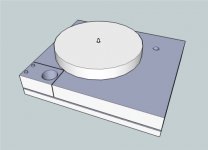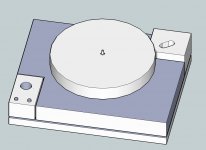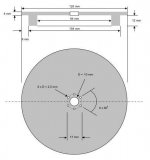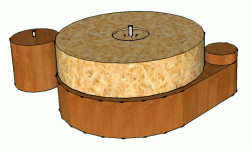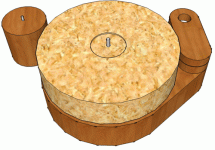Hello All.
I have begun collecting parts for my DIY turntable.
I have the Motor & Controller (Group Buy), Teres Bearing (Group Buy), and am in the process of getting a VTA and Clamp from Chris at Teres Audio. I will be using an RB250 (lowly, but I have one to use) and heavily modifying it.
I am looking for assistance in the design layout of this turntable. I'm not sure 'exactly' where the hole for the VTA/Arm needs to be placed, also if anyone has good advice on a plinth & platter design I would greatly appreciate it.
The main problem here is that I am very proficient when working with wood, with metal, forget about it. So I figure I will need to buy a motor pod, but other than that I would like to do this in all hardwood.
I figure I will keep it a square plinth, maybe a hollow box and fill it with a heavy substance. The motor pod will probably be mounted if I can figure out how to do it (I don't like the idea of it being free from the plinth). I really have no idea though on how to do the armboard.
Can anyone point me in the right direction, or give me some good layout ideas?
Thank You Very Much
-West
I have begun collecting parts for my DIY turntable.
I have the Motor & Controller (Group Buy), Teres Bearing (Group Buy), and am in the process of getting a VTA and Clamp from Chris at Teres Audio. I will be using an RB250 (lowly, but I have one to use) and heavily modifying it.
I am looking for assistance in the design layout of this turntable. I'm not sure 'exactly' where the hole for the VTA/Arm needs to be placed, also if anyone has good advice on a plinth & platter design I would greatly appreciate it.
The main problem here is that I am very proficient when working with wood, with metal, forget about it. So I figure I will need to buy a motor pod, but other than that I would like to do this in all hardwood.
I figure I will keep it a square plinth, maybe a hollow box and fill it with a heavy substance. The motor pod will probably be mounted if I can figure out how to do it (I don't like the idea of it being free from the plinth). I really have no idea though on how to do the armboard.
Can anyone point me in the right direction, or give me some good layout ideas?
Thank You Very Much
-West
DIY turntable adn stuff...
The Rega should have a mounting template with it. If not, check out "the vinyl engine". You may have to join to gain access to the library, and articles.
Personally I believe that an isolated motor is the best way to go. It can all be designed so that the "pod"(even if it is rectangular), can "index" to the main plinth and look like one unit.
I'll draw something up and post it later...
stew
The Rega should have a mounting template with it. If not, check out "the vinyl engine". You may have to join to gain access to the library, and articles.
Personally I believe that an isolated motor is the best way to go. It can all be designed so that the "pod"(even if it is rectangular), can "index" to the main plinth and look like one unit.
I'll draw something up and post it later...
stew
DIY turntable and stuff...con't1
whubbard,
I believe the "differing" mounting distances are due to different requirements for various alignments as you point out.
You could make a circular arm board that would rotate about the 222 mm mounting distance. Drill the 23 mm mounting hole offset from the centre of the board, taking the hardware required to attach the arm board to the plinth. Put a plug or get a "speedy nut" or similar, similar to the size of the pilot hole for the 222 mm location, and countersink a hole on the arm board.
I'd have to look a little closer at the Rega arm. If you need a substantial rise to get to the top of the Teres platter, it could work for you.
You could also a similar "separate" arm board, that would be similar to the motor pod. Both (and the plinth, proper) could be placed on a single piece of material. It would all look like a single plinth, but not be..
stew
whubbard,
I believe the "differing" mounting distances are due to different requirements for various alignments as you point out.
You could make a circular arm board that would rotate about the 222 mm mounting distance. Drill the 23 mm mounting hole offset from the centre of the board, taking the hardware required to attach the arm board to the plinth. Put a plug or get a "speedy nut" or similar, similar to the size of the pilot hole for the 222 mm location, and countersink a hole on the arm board.
I'd have to look a little closer at the Rega arm. If you need a substantial rise to get to the top of the Teres platter, it could work for you.
You could also a similar "separate" arm board, that would be similar to the motor pod. Both (and the plinth, proper) could be placed on a single piece of material. It would all look like a single plinth, but not be..
stew
Attachments
whubbard, mounting differences and alignment...
I should have also responded to your Q, concerning:
The alignment does have a profound effect on the sound.
The Rega arms have the following characteristics (geometry):
Effective length: 237 mm
Overhang:15 mm
Offset angle:21.63
mounting distance :222 mm
cart mass suitability: 4g-11g
Effective mass: 12 g
mount hole diameter: 23 mm
null points: 60.0 / 114.7
for an alternative alignment look here. Ihave found the "Guru" method to be very satisying on both of :
-Oracle Alex Mkll/SME 309 magnesium/Grado Sig 8
-original Roksan Xerxes/modified Rega RB250/ Ortofon MC-Turbo3
For analysis look here .
There are proponents of the various different alignments. Just remember that in the case of the Rega arms you have no adjustment for the cartridge in the arm, you can only move the arm itself.
stew
I should have also responded to your Q, concerning:
Is this all about cartridge alignment procedures, or could it actually affect the sound.
The alignment does have a profound effect on the sound.
The Rega arms have the following characteristics (geometry):
Effective length: 237 mm
Overhang:15 mm
Offset angle:21.63
mounting distance :222 mm
cart mass suitability: 4g-11g
Effective mass: 12 g
mount hole diameter: 23 mm
null points: 60.0 / 114.7
for an alternative alignment look here. Ihave found the "Guru" method to be very satisying on both of :
-Oracle Alex Mkll/SME 309 magnesium/Grado Sig 8
-original Roksan Xerxes/modified Rega RB250/ Ortofon MC-Turbo3
For analysis look here .
There are proponents of the various different alignments. Just remember that in the case of the Rega arms you have no adjustment for the cartridge in the arm, you can only move the arm itself.
stew
Thanks Stew,
That is a very nice read.
Do have by chance have any good photos of how to implement the motor pod 'attached' to the plinth, and a good way to have a fixed arm high enough to reach a taller platter?
I don't yet have the Teres platter, and I'm not sure if I am going to use on like it, but it would be useful to see some designs on how to get the arm to that height. The VTA can help a bit, but not that much.
I'm thinking my turntable will be much like that CAD image. Might have more rounded corners, and then I will just have another piece bellow that incorporates the motor pod. I think I will try and keep the armboard directly attached to the plinth.
-West
That is a very nice read.
Do have by chance have any good photos of how to implement the motor pod 'attached' to the plinth, and a good way to have a fixed arm high enough to reach a taller platter?
I don't yet have the Teres platter, and I'm not sure if I am going to use on like it, but it would be useful to see some designs on how to get the arm to that height. The VTA can help a bit, but not that much.
I'm thinking my turntable will be much like that CAD image. Might have more rounded corners, and then I will just have another piece bellow that incorporates the motor pod. I think I will try and keep the armboard directly attached to the plinth.
-West
the motor and arm "pods"
I would make them as separate pieces from the main plinth. You can then put them all on a slab of high mass (or ultra low-mass) material. There will be some very good isolation of the motor from the main bearing, and the tonearm. And the tonearm will be isolated from the platter bearing as well. There is an audible benefit to both.
The Teres is 3" I think, so the tonearm "plinth" (for lack of a better descriptor), could be made quite thick, or just the "off-centre" collar.
Look here for a picture of what I am talking about, although the offset from the mount would be much less. You could even make a 23mm X 35 mm or similar cut-out on the tonearm mount "plate". Using an aircraft style washer (very narrow shoulders), and the Rega nut would allow you to move it quite some distance, much like the SME "sled" style, but not as elegant.
For other ideas do a google search for "Teres turntable" under images. Tons pop up
I would make them as separate pieces from the main plinth. You can then put them all on a slab of high mass (or ultra low-mass) material. There will be some very good isolation of the motor from the main bearing, and the tonearm. And the tonearm will be isolated from the platter bearing as well. There is an audible benefit to both.
The Teres is 3" I think, so the tonearm "plinth" (for lack of a better descriptor), could be made quite thick, or just the "off-centre" collar.
Look here for a picture of what I am talking about, although the offset from the mount would be much less. You could even make a 23mm X 35 mm or similar cut-out on the tonearm mount "plate". Using an aircraft style washer (very narrow shoulders), and the Rega nut would allow you to move it quite some distance, much like the SME "sled" style, but not as elegant.
For other ideas do a google search for "Teres turntable" under images. Tons pop up
Originally posted by whubbard
The main problem here is that I am very proficient when working with wood, with metal, forget about it. So I figure I will need to buy a motor pod, but other than that I would like to do this in all hardwood.
West, aluminum is an easy step from wood - works with the same tools and sands at about the same rate, so shaping combined pieces is pretty easy if your good with ww tools. Only thing to be careful of is that the aluminum tends to grab edge tools, so routing can chatter if you don't have everything firmly under control, and cutting with a tablesaw goes more easily if you have a non-ferrous (negative rake) blade.
Try it, you may like it.
Regards.
Aengus
Stew,
I really like that armboard design. Shouldn't be too hard to implement. Might look a bit 'off' on a square plinth, but thats okay.
Aengus,
I think I will give it a shot sometime, but for now I'm going to stick to wood. Also most of my blades and cutting tools are very nice and expensive, and I wouldn't want to bang them up on aluminum. My Woodworker II blades aren't going near it
-West
I really like that armboard design. Shouldn't be too hard to implement. Might look a bit 'off' on a square plinth, but thats okay.
Aengus,
I think I will give it a shot sometime, but for now I'm going to stick to wood. Also most of my blades and cutting tools are very nice and expensive, and I wouldn't want to bang them up on aluminum. My Woodworker II blades aren't going near it
-West
That would be simpler, however it could make mounting the tonearm more complicated as I won't have easy access to the bottom.
I need to have a way to finish the whole table and then mount the VTA and arm.
Here is a nice link that shows the breakdown of the Teres Table:
Teres Review
The more I think about it, I might just make a clone of it.
-West
....I think I might just do this: DIY Table
and make the platter from wood as well.
I need to have a way to finish the whole table and then mount the VTA and arm.
Here is a nice link that shows the breakdown of the Teres Table:
Teres Review
The more I think about it, I might just make a clone of it.
-West
....I think I might just do this: DIY Table
and make the platter from wood as well.
Motor Pod
I thought I had the motor pod all figured out, but now I notice the top plate from DIY Hifi Supply isn't exactly what I was looking for. It would mount the motor fine, but it is missing two mounting holes, and has three other holes that would go unused.
Does anybody know where to get a good motor house and a top plate for the Maxon. I've attached what the top plate is meant to look like.
Thanks.
-West
I thought I had the motor pod all figured out, but now I notice the top plate from DIY Hifi Supply isn't exactly what I was looking for. It would mount the motor fine, but it is missing two mounting holes, and has three other holes that would go unused.
Does anybody know where to get a good motor house and a top plate for the Maxon. I've attached what the top plate is meant to look like.
Thanks.
-West
Attachments
Alright, I know what I'll do.
It's going to be ALL wood. Nice hardwood for the top of the motor pod, so it's secure, and fill a lot of it with lead shot, but it should be nice an sturdy. Plus I think it will look nice.
The platter will be wood as well.
-West
My 12 1/2" planer is going to be VERY useful for all this. I want to make sure it is all perfectly flat.
It's going to be ALL wood. Nice hardwood for the top of the motor pod, so it's secure, and fill a lot of it with lead shot, but it should be nice an sturdy. Plus I think it will look nice.
The platter will be wood as well.
-West
My 12 1/2" planer is going to be VERY useful for all this. I want to make sure it is all perfectly flat.
wood....
is a great material...
actually density is less than 1/2 that of vinyl, therefore broadband energy can easily be dissipated at a low quantity, without the typical build up in other materials. A peripheral ring can be added or created for increased mass to increase the flywheel effect.
I am almost tempted to create an ultra-light platter with cardboard and fibre glass or other material--the "ultimate low mass platter". The "toughest part in that might be to ensure the drive belt doesn't "dig into" the platter....
Whubbard, PM me if you want to discuss some "out of this world" or kinda "freaky" concepts regarding platter mass...
stew
is a great material...
actually density is less than 1/2 that of vinyl, therefore broadband energy can easily be dissipated at a low quantity, without the typical build up in other materials. A peripheral ring can be added or created for increased mass to increase the flywheel effect.
I am almost tempted to create an ultra-light platter with cardboard and fibre glass or other material--the "ultimate low mass platter". The "toughest part in that might be to ensure the drive belt doesn't "dig into" the platter....
Whubbard, PM me if you want to discuss some "out of this world" or kinda "freaky" concepts regarding platter mass...
stew
A more detailed explanation:
Platter:
Wood - Birds Eye Maple
Construction - Filled with lead shot.
Size - A bit over 12", with a soft edge on the outside, and an indent in the middle.
Plinth:
Wood -Mahogany or Cherry (Undecided)
Construction - Again, Filled with lead shot.
Size - area under platter will be the same size as the plater, with tangents over to the smaller circle, where the armboard will be mounted.
Armboard:
(Full armboard not shown bellow, it will be an extension off of the mounting platform that is in the photo.)
Wood - Same as Plinth
Construction: Will be bolted down. Bolt might be sunk in, and covered with a removable piece of wood.
Size - semi-circles on both sides, with radii the same as the edge of the plinth.
Motor House:
Wood - Same as plinth
Construction - Hollow with mounting plate on top, and cover on the bottom. A small flat section on the side for mounting the power connector. (Nuetrix). The bottom will then be filled with led shot to give it mass.
Motor Controller:
(Not shown)
Wood - Undecided, probably the same as the plinth.
Construction - Simple box, will have the 12V 18AH battery inside.
I also might build a larger plinth or stand to go under this all. Right now I am leaning towards a dedicated stand.
-West
Platter:
Wood - Birds Eye Maple
Construction - Filled with lead shot.
Size - A bit over 12", with a soft edge on the outside, and an indent in the middle.
Plinth:
Wood -Mahogany or Cherry (Undecided)
Construction - Again, Filled with lead shot.
Size - area under platter will be the same size as the plater, with tangents over to the smaller circle, where the armboard will be mounted.
Armboard:
(Full armboard not shown bellow, it will be an extension off of the mounting platform that is in the photo.)
Wood - Same as Plinth
Construction: Will be bolted down. Bolt might be sunk in, and covered with a removable piece of wood.
Size - semi-circles on both sides, with radii the same as the edge of the plinth.
Motor House:
Wood - Same as plinth
Construction - Hollow with mounting plate on top, and cover on the bottom. A small flat section on the side for mounting the power connector. (Nuetrix). The bottom will then be filled with led shot to give it mass.
Motor Controller:
(Not shown)
Wood - Undecided, probably the same as the plinth.
Construction - Simple box, will have the 12V 18AH battery inside.
I also might build a larger plinth or stand to go under this all. Right now I am leaning towards a dedicated stand.
-West
Attachments
- Status
- This old topic is closed. If you want to reopen this topic, contact a moderator using the "Report Post" button.
- Home
- Source & Line
- Analogue Source
- DIY - Turntable
